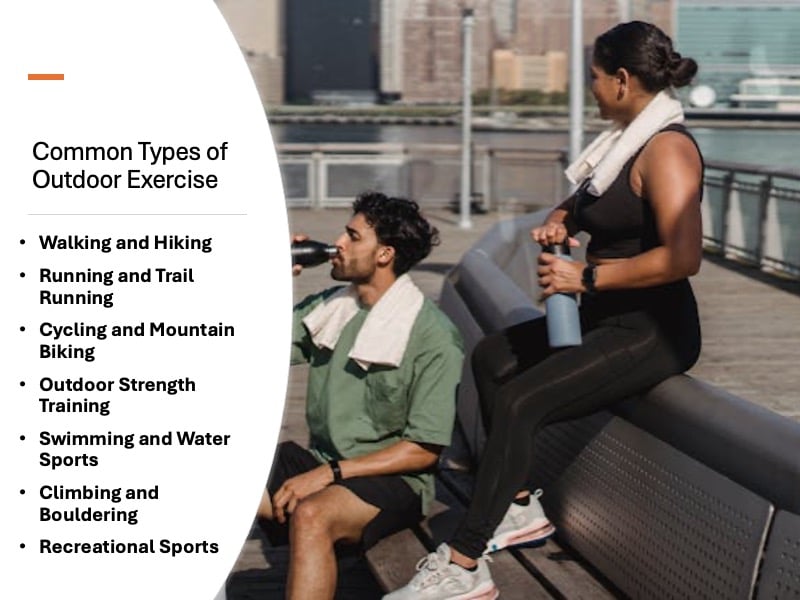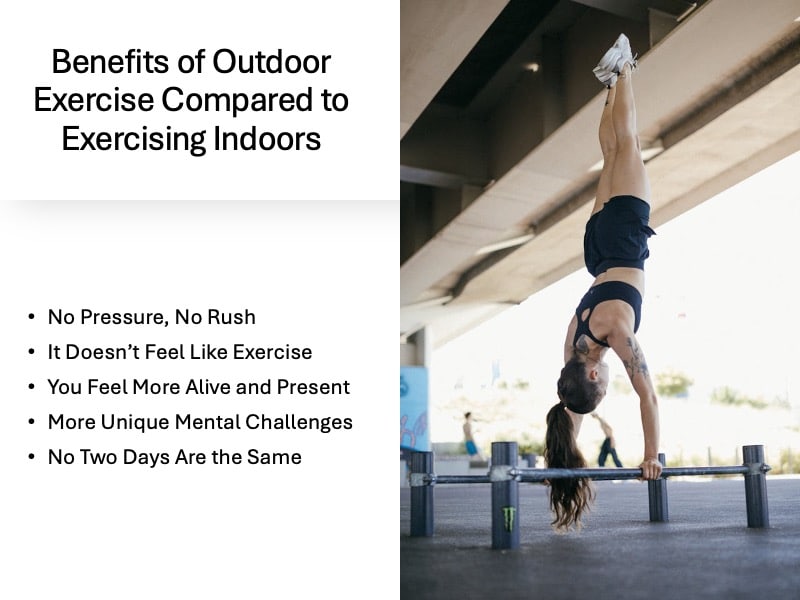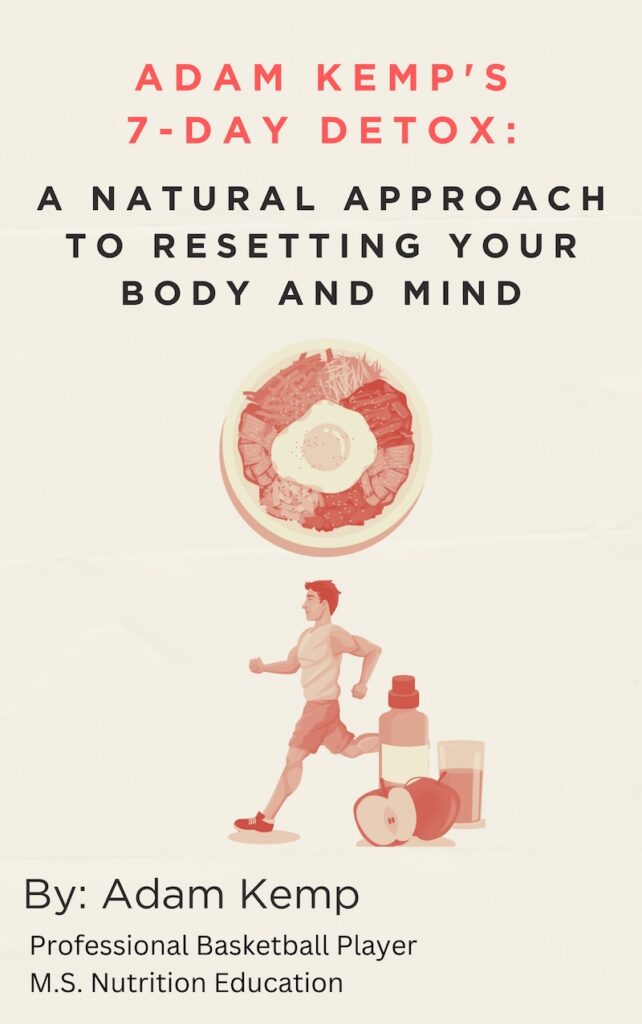Health Benefits of Outdoor Exercise & Why Outdoor is Better
The benefits of outdoor exercise go beyond a standard gym session, offering unique advantages for both your body and mind.
Moving outside exposes you to natural light, fresh air, and constantly changing terrain, all of which can have a measurable impact on both mental and physical health.
Research suggests that exercising in green spaces can lower cortisol levels, reduce symptoms of anxiety and depression, and improve mood more effectively than indoor workouts (Thompson Coon et al., 2011).
This connection between nature and movement taps into our evolutionary roots, when all human activity (whether for survival or exploration) occurred outside.
Outdoor environments present the body with unique challenges.
Walking or running on grass, sand, or trails forces your stabilizing muscles to work harder than they would on a flat gym floor or treadmill.
Exposure to natural sunlight also stimulates vitamin D production, which supports bone health, immune function, and overall vitality.
Mentally, the open sky and natural scenery create a sense of freedom that helps break the monotony of structured indoor routines.
Whether it’s a hike, a bike ride, or a simple walk through the park, outdoor exercise often feels less like a chore and more like an adventure.
The combination of fresh air, sensory stimulation, and movement makes you more present, engaged, and motivated.
By understanding the benefits of outdoor exercise, you can find new ways to enhance your fitness while reconnecting with the natural world.
Types of Outdoor Exercise

One of the greatest benefits of outdoor exercise is the variety of activities available for every fitness level and interest.
Unlike the predictable machines in a gym, outdoor workouts can be as structured or spontaneous as you want.
From cardio-based activities to strength and mobility-focused training, the options are nearly endless.
Engaging in these outdoor activities not only diversifies your fitness routine but also maximizes the physical and mental benefits of exercise, keeping your workouts fresh, challenging, and enjoyable.
Here are some of the most common forms of outdoor exercise:
Walking and Hiking
Walking and hiking are two of the most accessible outdoor exercises, requiring little more than comfortable shoes.
Walking on uneven terrain or hiking uphill engages stabilizing muscles, improves cardiovascular health, and enhances balance.
Running and Trail Running
Running outdoors, especially on trails, builds endurance while strengthening lower-body muscles in ways that flat treadmill surfaces cannot.
Trail running also improves agility and proprioception due to the need to adjust to obstacles and varying terrain.
Cycling
Road cycling and mountain biking are excellent ways to build cardiovascular endurance while exploring new environments.
Mountain biking, in particular, also challenges upper-body stability and core strength.
Outdoor Strength Training
Bodyweight exercises, such as push-ups, pull-ups, step-ups, or dips, can be performed in parks or on natural features like benches, logs, or rocks.
Some parks even have outdoor fitness stations designed for strength workouts.
Swimming and Water Sports
Open-water swimming, kayaking, or paddleboarding offer low-impact, full-body workouts that build endurance and strengthen stabilizing muscles while connecting you with nature.
Climbing and Bouldering
Rock climbing and bouldering combine strength, flexibility, and mental focus. They also add a sense of adventure and problem-solving to your workout.
Recreational Sports
Playing outdoor games like golf, tennis, soccer, basketball, or beach volleyball provides high-intensity bursts of exercise while boosting coordination and teamwork skills.
Benefits of Outdoor Exercise Compared to Exercising Indoors

While indoor workouts offer structure and convenience, outdoor exercise delivers a unique blend of physical, mental, and emotional advantages that are hard to replicate inside a gym.
Exercising in natural environments has been linked to improved mood, greater calorie burn due to varied terrain, and reduced feelings of stress and fatigue.
Fresh air, sunlight, and the constantly changing landscape provide sensory stimulation that makes workouts feel less repetitive and more enjoyable.
When comparing the benefits of outdoor exercise to indoor training, the difference often comes down to how engaged and energized you feel during and after the session.
Moving outdoors taps into a natural sense of freedom and adventure that motivates you to stay active longer and with less mental resistance.
Here is a closer look at some of the primary benefits of outdoor exercise, compared to working out at home or at a gym:
No Pressure, No Rush
One of the biggest differences between outdoor activities and gym sessions is the absence of noise. Both physical and mental.
Gyms often come with loud music, mirrors everywhere, machines lined up in rows, and an unspoken sense that everyone’s on a timer.
Even when you’re doing your own thing, there’s a kind of pressure to be efficient.
Outside, that pressure fades. You set your own pace.
There are no ticking clocks or glowing treadmills urging you to move faster. Your surroundings move slowly.
Trees swaying, clouds drifting, birds cutting across the sky.
That slower rhythm naturally seeps into your system.
You will find yourself doing more without having to force it.
It Doesn’t Feel Like Exercise
The word “workout” alone carries baggage.
For many people, it brings up thoughts of effort, rules, sweat, and pushing through.
But movement outdoors rarely feels like a chore. It’s play, challenge, and exploration all rolled into one.
Climb up a boulder, scramble across a rocky trail, or trek up a hill, and you’ll notice something.
You’re using every part of your body. But you’re not overthinking it.
You’re just moving the way your body was meant to.
A company like Black Diamond Equipment understands this well.
They don’t just sell climbing gear.
They build tools for people who want to move with purpose in wild places.
Whether you’re scaling granite or learning to trust your footing on your first outdoor climb, having the right equipment means you can focus on the experience itself.
You Feel More Alive and Present
Outdoors, your senses wake up.
The scent of pine, the warmth of sunlight, the crunch of dirt underfoot.
These small things bring you back into your body. You’re no longer zoning out between sets or staring at a wall waiting for your timer to go off.
There’s also something deeper at play.
Moving outside taps into a kind of memory your body already carries.
For most of human history, movement was tied to survival, gathering, building, and exploring.
We didn’t lift weights indoors under fluorescent lights.
We moved across landscapes.
So when you’re outside, even if you don’t realize it, your body remembers.
That sense of connection doesn’t stop with your surroundings.
Sharing a hike, a climb, or even a walk through the neighborhood with someone else builds bonds that are hard to form when you’re side by side on treadmills.
More Unique Mental Challenges
When you work out in a controlled environment, you know what to expect. The weights don’t change.
The treadmill speed stays the same.
But outside? It’s full of surprises.
Wind might pick up. Trails get muddy. Rocks shift.
These little moments of unpredictability force you to adjust.
You think on your feet.
You push through discomfort.
You notice your resilience building over time.
You don’t need a structured workout plan to build grit.
Sometimes it’s just about making it up that hill, crossing that stream, or going a little farther than you planned.
Due to these challenges and small accomplishments, when you finish, there’s a different kind of satisfaction.
You didn’t just exercise. You experienced something.
No Two Days Are the Same
Repetition is one of the fastest ways to lose interest.
Do the same workout five times a week, and you’ll start checking out halfway through.
But go outside, and no two days are alike.
Even if you walk the same path every morning, you’ll see something new.
A different flower blooming, a change in the air, fresh animal tracks in the mud.
Your surroundings evolve, and so does the way you move through them.
Climbers know this well.
A wall may stay in the same spot, but the route changes with the weather, the season, or even how your body feels that day.
Disadvantages of Exercising Outdoors
Although the benefits of outdoor exercise far outweigh the downsides, there are a few challenges to consider.
Weather, safety, and accessibility can sometimes limit outdoor workouts.
However, with proper planning, these issues are easily overcome.
Understanding these potential obstacles helps you prepare better and enjoy your time outside without interruptions.
Weather Conditions Can Be Unpredictable
Rain, snow, extreme heat, or cold can disrupt outdoor plans.
However, dressing appropriately, checking the forecast, and having a backup plan (such as bodyweight exercises at home) can help keep your routine consistent year-round.
Limited Access to Equipment
Outdoor workouts may lack the fitness equipment, such as workout machines and weights, available at a gym.
This can be solved by focusing on bodyweight exercises, resistance bands, or bringing portable equipment like kettlebells or suspension trainers.
Safety Concerns and Terrain Hazards
Uneven surfaces, busy roads, or low-light conditions can pose risks.
Wearing proper shoes, choosing safe routes, and using reflective gear in the evening can minimize these concerns.
Seasonal Allergies or Pollution
Pollen and air quality can affect breathing during certain times of year.
Exercising in the morning or after rainfall, or selecting low-pollen areas like the beach or forest trails, can reduce these issues.
Pro Tip: In addition to your regular allergy medications or treatments, I highly recommend trying local raw honey to help manage your seasonal allergies. Steadily consuming local raw honey during allergy season has made a remarkable difference in my severe allergies and asthma.
Limited Facilities for Recovery or Hydration
Outdoor spaces often lack water stations, shade, and recovery tools.
Carrying a reusable water bottle, wearing a hat, and planning shorter sessions during peak sun hours can help maintain comfort.
Final Thoughts: Health Benefits of Exercising Outdoors

You don’t need to abandon working out at home or going to the gym to enjoy the unique advantages of training outside.
Adding even one outdoor session each week can improve your mood, boost motivation, and challenge your body in ways that machines and flat gym floors cannot.
Most importantly, moving outdoors connects you with your environment and makes exercise feel less like a task and more like an experience.
Embrace the health benefits of exercising outdoors, let nature guide your pace, and rediscover the joy of movement!
This website does not provide medical advice. This website site does contain affiliate links, and purchases may earn a commission.
Read my Medical Disclaimer, Review Disclaimer, and Publishing Policies for more details. Use of this site indicates acceptance of these terms.



